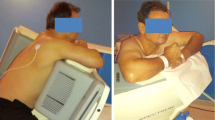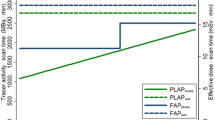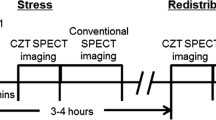Abstract
Background
The applicability of ultra-low-dose computed tomography (CT) for attenuation correction (AC) of single-photon-emission computed tomography myocardial perfusion imaging (SPECT-MPI) remains elusive.
Methods and results
One-hundred patients underwent one-day 99mTc-tetrofosmin stress-rest MPI and non-contrast enhanced cardiac CT with 120, 80, and 70 kilovolt peak (kVp) tube voltage and tube current of 200 milliamperes for creation of AC maps. Normalized percent myocardial uptake from SPECT-MPI using 80 kVp scans for AC showed excellent correlation vs AC from 120 kVp scans for stress [intraclass correlation (ICC) = 0.988, 95% CI = 0.986-0.989, P < .001] and rest (ICC = 0.985, 95% CI = 0.983-0.987, P < .001) with narrow Bland-Altman limits of agreement (BA-LA) (− 5.3% to 4.5% and − 5.4% to 4.4%, respectively) and minimal bias (− 0.4% and − 0.5%, respectively). Correlation of AC SPECT-MPI based on 70 vs 120 kVp scans was excellent for stress (ICC = 0.988, 95% CI = 0.986-0.989, P < .001) and rest (ICC = 0.986, 95% CI = 0.984-0.987, P < .001) with narrow BA-LA (− 5.3% to 4.4% and − 5.2% to 4.5%, respectively) and small bias (− 0.4% and − 0.3%, respectively). Mean effective radiation dose for the 120, 80 and 70 kVp scans were 0.58 ± 0.07, 0.19 ± 0.02, and 0.12 ± 0.01 mSv, respectively.
Conclusions
Attenuation maps for MPI obtained from ultra-low radiation dose CT scans are interchangeable with attenuation maps from standard-dose CT while offering a substantial reduction in radiation dose exposure.




Similar content being viewed by others
Abbreviations
- AC:
-
Attenuation correction
- CACS:
-
Coronary artery calcium score
- CZT:
-
Cadmium-zinc-telluride
- kVp:
-
Kilovolt peak
- mA:
-
Milliampere
- MBq:
-
Megabecquerel
- mGy:
-
Milligray
- mSv:
-
Millisievert
References
Fihn SD, Gardin JM, Abrams J, Berra K, Blankenship JC, Dallas AP, et al. 2012 ACCF/AHA/ACP/AATS/PCNA/SCAI/STS guideline for the diagnosis and management of patients with stable ischemic heart disease: A report of the American College of Cardiology Foundation/American Heart Association Task Force on Practice Guidelines, and the American College of Physicians, American Association for Thoracic Surgery, Preventive Cardiovascular Nurses Association, Society for Cardiovascular Angiography and Interventions, and Society of Thoracic Surgeons. Circulation 2012;126:e354-471.
Task Force M, Montalescot G, Sechtem U, Achenbach S, Andreotti F, Arden C, et al. 2013 ESC guidelines on the management of stable coronary artery disease: The Task Force on the Management of Stable Coronary Artery Disease of the European Society of Cardiology. Eur Heart J 2013;34:2949-3003.
Acampa W, Gaemperli O, Gimelli A, Knaapen P, Schindler TH, Verberne HJ, et al. Role of risk stratification by SPECT, PET, and hybrid imaging in guiding management of stable patients with ischaemic heart disease: Expert Panel of the EANM Cardiovascular Committee and EACVI. Eur Heart J Cardiovasc Imaging 2015;16:1289-98.
Burrell S, MacDonald A. Artifacts and pitfalls in myocardial perfusion imaging. J Nucl Med Technol 2006;34:193-211; quiz 2-4.
Slomka P, Xu Y, Berman D, Germano G. Quantitative analysis of perfusion studies: Strengths and pitfalls. J Nucl Cardiol 2012;19:338-46.
Nishina H, Slomka PJ, Abidov A, Yoda S, Akincioglu C, Kang X, et al. Combined supine and prone quantitative myocardial perfusion SPECT: Method development and clinical validation in patients with no known coronary artery disease. J Nucl Med 2006;47:51-8.
Slomka PJ, Nishina H, Abidov A, Hayes SW, Friedman JD, Berman DS, et al. Combined quantitative supine-prone myocardial perfusion SPECT improves detection of coronary artery disease and normalcy rates in women. J Nucl Cardiol 2007;14:44-52.
Tan P, Bailey DL, Meikle SR, Eberl S, Fulton RR, Hutton BF. A scanning line source for simultaneous emission and transmission measurements in SPECT. J Nucl Med 1993;34:1752-60.
Herzog BA, Buechel RR, Husmann L, Pazhenkottil AP, Burger IA, Wolfrum M, et al. Validation of CT attenuation correction for high-speed myocardial perfusion imaging using a novel cadmium–zinc–telluride detector technique. J Nucl Med 2010;51:1539-44.
Pazhenkottil AP, Ghadri JR, Nkoulou RN, Wolfrum M, Buechel RR, Kuest SM, et al. Improved outcome prediction by SPECT myocardial perfusion imaging after CT attenuation correction. J Nucl Med 2011;52:196-200.
Thompson RC, Heller GV, Johnson LL, Case JA, Cullom SJ, Garcia EV, et al. Value of attenuation correction on ECG-gated SPECT myocardial perfusion imaging related to body mass index. J Nucl Cardiol 2005;12:195-202.
Grossman GB, Garcia EV, Bateman TM, Heller GV, Johnson LL, Folks RD, et al. Quantitative Tc-99m sestamibi attenuation-corrected SPECT: Development and multicenter trial validation of myocardial perfusion stress gender-independent normal database in an obese population. J Nucl Cardiol 2004;11:263-72.
Dorbala S, Di Carli MF, Delbeke D, Abbara S, DePuey EG, Dilsizian V, et al. SNMMI/ASNC/SCCT guideline for cardiac SPECT/CT and PET/CT 1.0. J Nucl Med 2013;54:1485-507.
Schepis T, Gaemperli O, Koepfli P, Ruegg C, Burger C, Leschka S, et al. Use of coronary calcium score scans from stand-alone multislice computed tomography for attenuation correction of myocardial perfusion SPECT. Eur J Nucl Med Mol Imaging 2007;34:11-9.
Einstein AJ, Pascual TN, Mercuri M, Karthikeyan G, Vitola JV, Mahmarian JJ, et al. Current worldwide nuclear cardiology practices and radiation exposure: Results from the 65 country IAEA Nuclear Cardiology Protocols Cross-Sectional Study (INCAPS). Eur Heart J 2015;36:1689-96.
Buechel RR, Herzog BA, Husmann L, Burger IA, Pazhenkottil AP, Treyer V, et al. Ultrafast nuclear myocardial perfusion imaging on a new gamma camera with semiconductor detector technique: First clinical validation. Eur J Nucl Med Mol Imaging 2010;37:773-8.
Duvall WL, Croft LB, Ginsberg ES, Einstein AJ, Guma KA, George T, et al. Reduced isotope dose and imaging time with a high-efficiency CZT SPECT camera. J Nucl Cardiol 2011;18:847-57.
Einstein AJ, Johnson LL, DeLuca AJ, Kontak AC, Groves DW, Stant J, et al. Radiation dose and prognosis of ultra-low-dose stress-first myocardial perfusion SPECT in patients with chest pain using a high-efficiency camera. J Nucl Med 2015;56:545-51.
van Dijk JD, Borren NM, Mouden M, van Dalen JA, Ottervanger JP, Jager PL. Effect of a patient-specific minimum activity in stress myocardial perfusion imaging using CZT-SPECT: Prognostic value, radiation dose, and scan outcome. J Nucl Cardiol 2018;25:26-35.
Songy B, Guernou M, Hivoux D, Attias D, Lussato D, Queneau M, et al. Prognostic value of one millisievert exercise myocardial perfusion imaging in patients without known coronary artery disease. J Nucl Cardiol 2018;25:120-30.
Nakazato R, Dey D, Gutstein A, Le Meunier L, Cheng VY, Pimentel R, et al. Coronary artery calcium scoring using a reduced tube voltage and radiation dose protocol with dual-source computed tomography. J Cardiovasc Comput Tomogr 2009;3:394-400.
Marwan M, Mettin C, Pflederer T, Seltmann M, Schuhback A, Muschiol G, et al. Very low-dose coronary artery calcium scanning with high-pitch spiral acquisition mode: Comparison between 120-kV and 100-kV tube voltage protocols. J Cardiovasc Comput Tomogr 2013;7:32-8.
Gräni C, Vontobel J, Benz DC, Bacanovic S, Giannopoulos AA, Messerli M, et al. Ultra-low-dose coronary artery calcium scoring using novel scoring thresholds for low tube voltage protocols—a pilot study. Eur Heart J Cardiovasc Imaging 2018. https://doi.org/10.1093/ehjci/jey019.
Henzlova MJ, Duvall WL, Einstein AJ, Travin MI, Verberne HJ. ASNC imaging guidelines for SPECT nuclear cardiology procedures: Stress, protocols, and tracers. J Nucl Cardiol 2016;23:606-39.
Gebhard C, Fiechter M, Fuchs TA, Ghadri JR, Herzog BA, Kuhn F, et al. Coronary artery calcium scoring: Influence of adaptive statistical iterative reconstruction using 64-MDCT. Int J Cardiol 2013;167:2932-7.
Hausleiter J, Meyer T, Hermann F, Hadamitzky M, Krebs M, Gerber TC, et al. Estimated radiation dose associated with cardiac CT angiography. JAMA 2009;301:500-7.
van Dijk JD, van Dalen JA, Mouden M, Ottervanger JP, Knollema S, Slump CH, et al. Value of automatic patient motion detection and correction in myocardial perfusion imaging using a CZT-based SPECT camera. J Nucl Cardiol 2018;25:419-28.
Clerc OF, Fuchs TA, Possner M, Vontobel J, Mikulicic F, Stehli J, et al. Real-time respiratory triggered SPECT myocardial perfusion imaging using CZT technology: Impact of respiratory phase matching between SPECT and low-dose CT for attenuation correction. Eur Heart J Cardiovasc Imaging 2017;18:31-8.
Zafrir N, Shafir G, Kovalski G, Mats I, Bouhnik JP, Battler A, et al. Yield of a novel ultra-low-dose computed tomography device mounted on a dedicated cardiac SPECT system in improving the accuracy of myocardial perfusion imaging and the detection of chest abnormalities. J Nucl Cardiol 2012;19:303-10.
Preuss R, Weise R, Lindner O, Fricke E, Fricke H, Burchert W. Optimisation of protocol for low dose CT-derived attenuation correction in myocardial perfusion SPECT imaging. Eur J Nucl Med Mol Imaging 2008;35:1133-41.
Xia T, Alessio AM, De Man B, Manjeshwar R, Asma E, Kinahan PE. Ultra-low dose CT attenuation correction for PET/CT. Phys Med Biol 2012;57:309-28.
Wu TH, Lu KM, Wu NY, Wang SJ, Mok GS, Yang BH, et al. The feasibility of low-dose CT protocols for coronary artery calcium scoring and PET attenuation correction in cardiac PET/CT. Nucl Med Commun 2015;36:376-85.
Bernstine H, Sopov V, Yefremov N, Nidam M, Gabbai M, Sosna J, et al. Comparison of 80 and 120 kVp contrast-enhanced CT for attenuation correction in PET/CT, using quantitative analysis and reporter assessment of PET image quality. Clin Radiol 2014;69:e17-24.
Schindler A, Vliegenthart R, Schoepf UJ, Blanke P, Ebersberger U, Cho YJ, et al. Iterative image reconstruction techniques for CT coronary artery calcium quantification: Comparison with traditional filtered back projection in vitro and in vivo. Radiology 2014;270:387-93.
Gimelli A, Achenbach S, Buechel RR, Edvardsen T, Francone M, Gaemperli O, et al. Strategies for radiation dose reduction in nuclear cardiology and cardiac computed tomography imaging: A report from the European Association of Cardiovascular Imaging (EACVI), the Cardiovascular Committee of European Association of Nuclear Medicine (EANM), and the European Society of Cardiovascular Radiology (ESCR). Eur Heart J 2018;39:286-96.
Kaufmann PA, Knuuti J. Ionizing radiation risks of cardiac imaging: Estimates of the immeasurable. Eur Heart J 2011;32:269-71.
Schauer DA, Linton OW. National Council on Radiation Protection and Measurements report shows substantial medical exposure increase. Radiology 2009;253:293-6.
Disclosure
The University Hospital Zurich holds a Research Agreement with GE Healthcare.
Author information
Authors and Affiliations
Corresponding author
Additional information
The authors of this article have provided a PowerPoint file, available for download at SpringerLink, which summarizes the contents of the paper and is free for re-use at meetings and presentations. Search for the article DOI on SpringerLink.com.
Marvin Grossmann and Andreas A. Giannopoulos share first authorship.
All editorial decisions for this article, including selection of reviewers and the final decision, were made by guest editor Stephan Nekolla, MD.
Electronic supplementary material
Below is the link to the electronic supplementary material.
Rights and permissions
About this article
Cite this article
Grossmann, M., Giannopoulos, A.A., Bechtiger, F.A. et al. Ultra-low-dose computed tomography for attenuation correction of cadmium-zinc-telluride single photon emission computed tomography myocardial perfusion imaging. J. Nucl. Cardiol. 27, 228–237 (2020). https://doi.org/10.1007/s12350-018-1303-y
Received:
Accepted:
Published:
Issue Date:
DOI: https://doi.org/10.1007/s12350-018-1303-y




